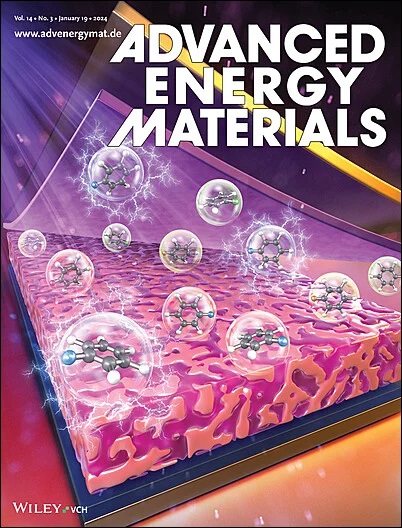Reshaping Electrical Double Layer via Synergistic Dual Additives for Ah‐Level Zinc Battery
IF 24.4
1区 材料科学
Q1 CHEMISTRY, PHYSICAL
引用次数: 0
Abstract
Aqueous Zn batteries hold great promise for large‐scale energy storage due to their high energy density, safety, and cost‐effectiveness. Electrolyte composition directly affects Zn anode stability, and additive engineering is an attractive and cost‐efficient strategy to suppress dendrite growth and inhibit side reactions. Unlike conventional single‐component additive strategies that offer limited effectiveness and targeted control, this work presents a novel synergistic dual‐additive (SDA) strategy that collaboratively modulates the electrical double layer (EDL). The fine‐tuning of hydrophobicity enables molecules to function as either water repellents or hydrogen bond disruptors, granting them the ability to selectively modify either the inner or the outer Helmholtz plane, together achieving a complementary reshape of the EDL. Through theoretical calculations and characterizations, it is revealed that SDA effectively suppresses side reactions at the Zn‐electrolyte interface, enabling uniform Zn deposition and minimizing the impact of additives on Zn reaction kinetics and electrolyte cost. This synergistic strategy enables a Zn anode lifespan exceeding 2000 h, and an ultra‐high areal capacity of 50 mAh cm利用协同双添加剂重塑Ah级锌电池的双电层
由于其高能量密度、安全性和成本效益,水锌电池在大规模储能方面具有很大的前景。电解质组成直接影响Zn阳极的稳定性,添加剂工程是抑制枝晶生长和抑制副反应的一种有吸引力且经济有效的策略。与传统的单组分加性策略(提供有限的有效性和目标控制)不同,这项工作提出了一种新的协同双组分加性(SDA)策略,可以协同调节电双层(EDL)。疏水性的微调使分子既可以作为拒水剂,也可以作为氢键破坏者,使它们能够选择性地修改内部或外部亥姆霍兹平面,共同实现EDL的互补重塑。通过理论计算和表征表明,SDA有效抑制了Zn -电解质界面的副反应,实现了均匀的Zn沉积,并最大限度地减少了添加剂对Zn反应动力学和电解质成本的影响。这种协同策略使锌阳极的寿命超过2000小时,并具有50 mAh cm - 2的超高面容量。因此,SDA优化的无阳极Zn - Br电池表现出超过3000次的稳定循环,并实现了91 Wh kg - 1的高能量密度的Ah级电池,为实用的Zn基储能解决方案铺平了道路。
本文章由计算机程序翻译,如有差异,请以英文原文为准。
求助全文
约1分钟内获得全文
求助全文
来源期刊

Advanced Energy Materials
CHEMISTRY, PHYSICAL-ENERGY & FUELS
CiteScore
41.90
自引率
4.00%
发文量
889
审稿时长
1.4 months
期刊介绍:
Established in 2011, Advanced Energy Materials is an international, interdisciplinary, English-language journal that focuses on materials used in energy harvesting, conversion, and storage. It is regarded as a top-quality journal alongside Advanced Materials, Advanced Functional Materials, and Small.
With a 2022 Impact Factor of 27.8, Advanced Energy Materials is considered a prime source for the best energy-related research. The journal covers a wide range of topics in energy-related research, including organic and inorganic photovoltaics, batteries and supercapacitors, fuel cells, hydrogen generation and storage, thermoelectrics, water splitting and photocatalysis, solar fuels and thermosolar power, magnetocalorics, and piezoelectronics.
The readership of Advanced Energy Materials includes materials scientists, chemists, physicists, and engineers in both academia and industry. The journal is indexed in various databases and collections, such as Advanced Technologies & Aerospace Database, FIZ Karlsruhe, INSPEC (IET), Science Citation Index Expanded, Technology Collection, and Web of Science, among others.
 求助内容:
求助内容: 应助结果提醒方式:
应助结果提醒方式:


